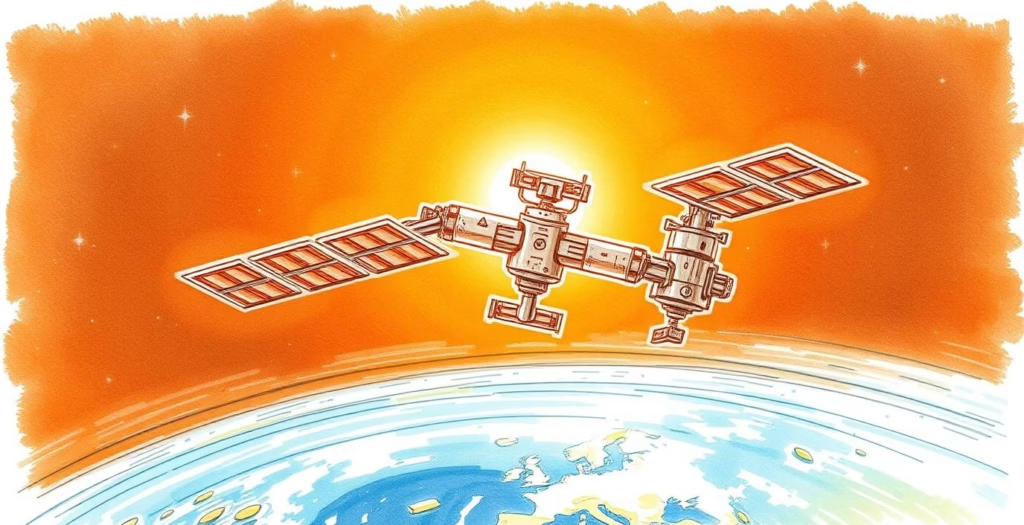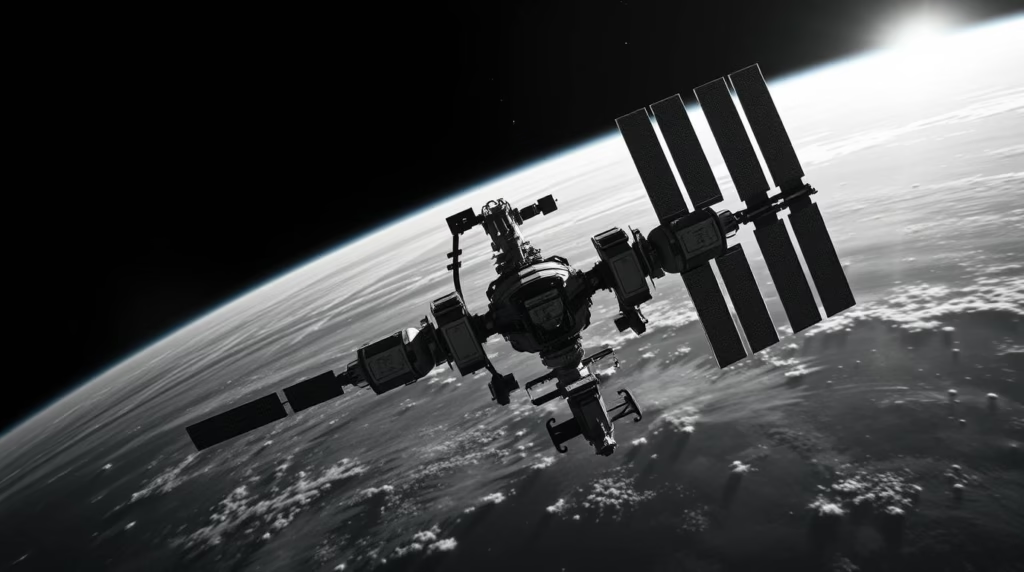International Space Station Set for Final Descent into Point Nemo in 2030
For more than two decades, the International Space Station (ISS) has symbolized what humanity can achieve when nations unite in the pursuit of science, exploration, and innovation. Orbiting Earth since 1998, it has served as a pioneering outpost for astronauts, scientists, and researchers who worked together beyond political and geographical boundaries. But all monumental endeavors have their closure, and the ISS is nearing its final journey. By the year 2030, the world’s most iconic space laboratory will be deliberately deorbited, marking the end of an era in human spaceflight.
The decision to retire the ISS is not sudden. Ageing infrastructure, escalating maintenance costs, and evolving plans for next-generation orbital platforms have collectively led NASA and its international partners to decide on a planned, carefully controlled deorbit. Rather than allowing the station to degrade naturally and risk an uncontrolled reentry, NASA has developed a strategy to guide it precisely into Earth’s atmosphere, ensuring both safety and sustainability. The destination chosen for this final descent is a location as remote as the ISS itself once was—the mysterious “Point Nemo.”

The Legacy of the International Space Station
Since its first module, Zarya, was launched in 1998, the ISS has been a marvel of collaboration. Constructed through a partnership involving the United States, Russia, the European Space Agency, Japan, and Canada, it became the largest and most sophisticated structure ever assembled in space. The ISS has orbited Earth approximately every 90 minutes, offering scientists unique opportunities to conduct experiments that could not be replicated on the ground.
Over its operational lifespan, the ISS contributed significantly to research in fields such as medicine, biology, physics, materials science, and planetary studies. Experiments conducted aboard have helped advance understanding of how microgravity affects the human body—an essential step toward future missions to the Moon and Mars. The insights gained have influenced everything from new cancer treatment techniques to climate monitoring efforts.
Moreover, the ISS showcased how nations can collaborate peacefully in space even amidst tensions on Earth. It hosted more than 250 astronauts from 20 different countries, demonstrating the potential of international unity when focused on scientific progress instead of rivalry. However, after more than 30 years of service, the wear and tear of constant exposure to the harsh conditions of space have become impossible to ignore.
Why the ISS Must Retire
Every spacecraft has a defined operational life, and the ISS is no exception. Despite regular maintenance and upgrades, the station’s aging hardware has shown increasing vulnerability. Modules built in the early 2000s are reaching the limits of their expected durability, and maintaining them has become both technically challenging and financially demanding.
NASA and its partners have kept the ISS functional far beyond its original design plan by replacing components, upgrading systems, and performing periodic repairs during spacewalks. However, metal fatigue, micro-meteoroid impacts, and radiation exposure have gradually weakened parts of its structure. The cost of extending its life any further is increasingly difficult to justify compared to investing in new orbital platforms designed with modern materials and technology.
Safety is another critical factor. As time passes, the risk of system failures grows. NASA has concluded that deorbiting the ISS in a controlled manner is a more responsible approach than waiting for unforeseen incidents. Retiring the station will pave the way for a transition to commercially operated space habitats that can continue research activities safely and more efficiently.
Where Will the Space Giant Fall?
Once NASA determined that the ISS should be retired, the next major question was where and how it should return to Earth. Allowing such a massive structure—spanning the size of a football field—to reenter the atmosphere uncontrolled would pose significant hazards. Even though much of it will burn up during descent, scattered debris could potentially damage property or injure people if not directed to a safe location.
To eliminate that risk, NASA selected “Point Nemo,” the most remote region of the global ocean, as the target for the ISS’s descent. Officially called the South Pacific Ocean Uninhabited Area (SPOUA), Point Nemo has long served as a “spacecraft cemetery” where space agencies send decommissioned satellites and stations to rest beneath the waves. More than 260 spacecraft debris, including Russia’s Mir space station and various cargo vehicles, already lie in this secluded stretch of the Pacific.
The Mystery and Meaning of Point Nemo
Point Nemo is an extraordinary location that owes both its name and fame to literature and science. Jules Verne’s renowned book Twenty Thousand Leagues Under the Sea and its fictional submarine captain served as the inspiration for the moniker “Nemo.” The Latin root of the word “Nemo” means “no one,” symbolizing both remoteness and absence. It is a fitting name for a point on Earth that is literally farther from any human habitation than anywhere else.
Geographically, Point Nemo is situated about 2,688 kilometers from the nearest landmass—roughly equidistant from Ducie Island (part of the Pitcairn group), Easter Island’s Motu Nui, and the Antarctic coast. The vast emptiness of this oceanic region ensures almost no risk to shipping or population centers when space debris reenters the atmosphere. Scientists selected it precisely because it is so isolated. At times, the nearest humans to Point Nemo are the astronauts orbiting hundreds of kilometers above in the ISS itself, illustrating just how lonely this oceanic void truly is.
The depth beneath Point Nemo plunges thousands of meters below the surface, making it an ideal final resting place for metallic fragments that survive atmospheric collapse. Over the decades, countless spacecraft have ended their journeys here, making the area an unintentional museum of our spacefaring history, hidden in the abyss.

The Controlled Deorbit Plan
Safely guiding a structure as massive as the ISS back to Earth is no simple task. NASA’s engineers have drawn up a meticulous plan involving a controlled reentry operation to ensure that pieces do not scatter uncontrollably. A specialized “deorbit vehicle” will be built for this mission, potentially with the collaboration of private partners such as SpaceX or Northrop Grumman.
This vehicle will dock with the ISS before the deorbit operation begins. Its engines will gradually lower the station’s orbit, step by step, over several days or weeks. Once the altitude is sufficiently reduced, the final maneuver will direct the ISS toward the coordinates of Point Nemo. Upon reentry into Earth’s atmosphere, frictional heat and pressure will cause most of the structure to incinerate completely. Only small, dense portions—such as reinforced trusses and docking ports—may survive the fiery descent. These remnants are expected to sink harmlessly to the ocean floor, joining the resting debris of other spacecraft from previous decades.
NASA’s careful control over the timing, angle, and thrusting sequence of the descent minimizes the risk of any debris escaping the designated zone. The entire process represents both technological precision and environmental responsibility, ensuring a safe closure to one of humanity’s most remarkable engineering achievements.
Why Point Nemo Was Chosen
Beyond its isolation, Point Nemo offers several scientific and logistical advantages. The region’s predictable sea currents and sparse maritime traffic make it perfect for controlled reentries. Recovering debris from this site is almost impossible due to distance and depth, which further reduces the temptation or hazard of retrieval attempts.
Environmental studies have shown that materials reaching the ocean floor here break down slowly without significant ecological disturbance due to the absence of complex ecosystems at those depths. NASA’s environmental scientists have ensured that debris from the ISS will pose minimal long-term impact on marine life. The selection of Point Nemo, therefore, reflects not only practicality but also the agency’s commitment to sustainable space operations.
In addition, the long-standing precedent of using this area for spacecraft disposal aligns with international practice. Other agencies, such as Roscosmos, JAXA, and ESA, have used the same coordinate range for decades, reinforcing its role as the primary “spacecraft graveyard” of the modern age.
What Comes After 2030: The Future of Space Habitats
When the ISS finally makes its descent, humanity’s presence in earth orbit will not end. Instead, it will evolve. NASA, alongside private and international collaborators, has already begun developing new generations of orbital outposts that will replace the ISS as research hubs in space.
Private space companies like Axiom Space, Blue Origin, Sierra Space, and SpaceX are leading the design of modular commercial stations. These stations are smaller, more efficient, and designed with modern sustainability principles in mind. Axiom Station, for instance, will initially attach to the ISS before eventually detaching to operate independently. Concepts like Orbital Reef—proposed by Blue Origin and Sierra Space—envision mixed-use platforms combining research, tourism, and industrial applications.
These commercial stations promise to reduce operational costs through reusable modules and renewable energy systems. By involving the private sector, NASA can redirect resources toward its Artemis missions to the Moon and its long-term goal of sending humans to Mars.
Continued Research in Low-Earth Orbit
NASA and its partners are committed to ensuring that the retirement of the ISS does not interrupt ongoing space research. The agency plans a smooth transition where current scientific experiments will migrate to new orbital facilities. Low-Earth orbit remains the ideal location for testing human endurance, materials durability, and life-support systems required for deep-space exploration.
Even after the ISS’s deorbit, the knowledge and expertise gained from its 30-year operation will guide future missions. The station’s legacy lives on in thousands of published studies, technological innovations, and international collaborations. Its experiments have shaped how we understand human physiology under microgravity, crop growth beyond Earth, and the resilience of microorganisms in space.

The Symbolism Behind the Final Dive
The planned deorbit into Point Nemo is more than a technical maneuver—it’s a symbolic gesture. The ISS, which circled Earth over 100,000 times, will return to the same planet that enabled its creation, closing the loop of human achievement in low-Earth orbit. Just as Captain Nemo sailed through uncharted waters in Verne’s imagination, the ISS’s descent into the deepest, most desolate ocean captures the dual spirit of exploration and humility.
Humanity’s ventures into the cosmos have always been about looking outward while remembering our place in the universe. As the ISS disappears beneath the Pacific, it will remind future generations that exploration is not finite—it evolves. The structure may vanish, but its contributions will continue to fuel curiosity and progress for decades.
A New Era of Exploration Awaits
By 2030, when the ISS completes its final mission, it will have spent over three decades as a beacon of international cooperation and technological brilliance. Its controlled descent into Point Nemo will symbolize the peaceful conclusion of a remarkable chapter in human spaceflight history. But it also marks the dawn of a new era—one driven by commercial innovation, sustainable technology, and deeper exploration beyond Earth.
From orbiting laboratories to lunar gateways and Mars habitats, space exploration will continue to push boundaries. The ISS may rest in the depths of the Pacific Ocean, but its legacy will rise anew through every mission that follows.
like this article visit BB